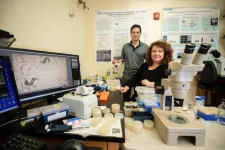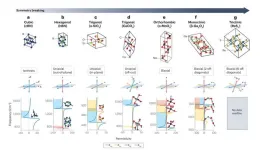(Press-News.org) BIRMINGHAM, Ala. – A groundbreaking 3D, three-layer nanomatrix vascular sheet that possesses multiple features of atherosclerosis has been applied for developing a high-throughput functional assay of drug candidates to treat this disease, University of Alabama at Birmingham researchers report in the journal Biomaterials.
“Current in vitro atherosclerosis models have significant limitations, including the lack of three-layer vascular architecture and limited atherosclerotic features,” said Ho-Wook Jun, Ph.D., a professor in the UAB Department of Biomedical Engineering and the corresponding author. “Moreover, no scalable 3D atherosclerosis model is available for the evaluation of potential therapeutics via high-throughput assays.”
Cardiovascular disease — primarily caused by atherosclerosis — is the leading cause of death in the United States. In the development of effective therapies for atherosclerosis, in vitro models are commonly utilized to assess the efficacy and safety of novel therapeutics before proceeding to complex in vivo and clinical studies.
Recently, the United States Food and Drug Agency Modernization Act 2.0 has permitted the use of alternative models other than animals for drug testing before progressing to human trials. This transformative change in regulations serves as a driving force, inspiring the pursuit of advanced in vitro models, such as cell-based assays and organoid- or artificial intelligence-based models that are capable of replacing or reducing animal use in assessing drug efficacy and safety. The goal is to expedite progression from preclinical research to human clinical trials via a more efficient and cost-effective drug development process.
The novel in vitro 3D, three-layer nanomatrix vascular sheet with critical atherosclerosis multi-features, or VSA, includes endothelial cell dysfunction, monocyte recruitment, presence of macrophages, extracellular matrix remodeling, smooth muscle cell phenotype transition, inflammatory cytokine secretion, foam cells and calcification initiation. The VSA thus provides a human atherosclerosis-mimicking environment for drug evaluation.
The three layers of the robust vascular sheet, or VS, structure are composed of: 1) human aortic endothelial cells, 2) human aortic smooth muscle cells and 3) human aortic adventitial fibroblasts layers. These mimic the layered structure of the native vascular wall, which, from inside out, is composed of the tunica intima, tunica media and tunica adventitia tissues. The researchers created the critical atherosclerosis multi-features by adding monocytes and various pro-atherosclerotic cytokines, colony-stimulating factors and oxidized low-density lipoprotein to stimulate atherogenesis on the 3D, layered nanomatrix vascular sheet.
Co-first author Jun Chen, Ph.D., and colleagues used this VSA system to create high-throughput functional assays by fabricating multiple VSAs in 48-well plates. The VSAs were subjected to drug treatments and then were comprehensively characterized, with a focus on evaluating foam cells, inflammation and atherosclerosis-associated genes.
High-throughput functional assays were validated using two classic atherosclerosis drugs, rosuvastatin and sirolimus, and were used to evaluate two drug candidates, curcumin and colchicine, and a potential gene therapy candidate, microRNA-146a-loaded liposomes, for treating atherosclerosis. The researchers found that the VSAs replicated a number of results seen by others in in vivo tests of these treatments. “The high efficiency and scalability of the VSA-evaluated functional assays should facilitate drug discovery and development for atherosclerosis,” Chen said.
“Our study focuses on demonstrating the use of VSAs as a cost-effective and efficient way to investigate therapeutic effectiveness,” Jun said. “The VSAs offer a high-throughput methodology and allow for a relatively large number of biological replicates, also making them ideal for mechanistic research. For instance, VSAs can be customized to induce atherosclerosis on single-, double- or three-layer structures, which provides insights into the effect of discrete layers on atherogenesis, particularly the fibroblast layer. Furthermore, the vascular sheets can be scaled up to develop high-throughput assays for drug safety testing, helping determine pharmacological and toxicological parameters for use in animal models.”
The Birmingham-based Endomimetics, LLC, has licensed the new 3D, three-layer nanomatrix vascular sheet atherosclerosis model technology through UAB’s Bill L. Harbert Institute for Innovation and Entrepreneurship, which manages university intellectual property.
“The atherosclerosis drug market is a large and growing segment of the pharmaceutical industry,” said Joseph Garner, Ph.D., CEO of Endomimetics. “This market is experiencing significant growth due to the rising prevalence of cardiovascular diseases, advancements in pharmaceutical research and the development of innovative atherosclerosis treatments. By 2032, this market is projected to reach $26.9 billion with a 2.8 percent compound annual growth rate from 2023 to 2032. North America currently holds the dominant market share at more than 41 percent.”
Brigitta Brott, M.D., a co-author and an interventional cardiologist and professor in the UAB Department of Medicine Division of Cardiovascular Disease, said, “Endomimetics and UAB will collaborate with pharmaceutical companies to evaluate potential candidates for atherosclerosis treatment, utilizing our VSA-based efficacy and safety assays. This approach can also be extended to assess other drugs for conditions such as diabetes, obesity and liver-related diseases, where atherosclerosis is prevalent among many patients.”
Endomimetics anticipates providing this innovative atherosclerosis model this spring for evaluating various types of potential therapeutics. “Our atherosclerosis assays will pave the way for therapeutic candidates directly targeting human plaque and the atherosclerotic artery wall, and they will generate extensive predictive data on their responses, which is crucial for defining the therapeutic window of these candidates and providing essential groundwork for future studies,” Jun said.
At Endomimetics, Jun is chief scientific officer and Brott is chief medical officer.
Co-authors with Jun, Chen and Brott in the study, “Atherosclerotic three-layer nanomatrix vascular sheets for high-throughput therapeutic evaluation,” are Xixi Zhang, Robbie Cross Jr., Yujin Aha, Gillian Huskin, UAB Department of Biomedical Engineering; Will Evans, Augusta University/University of Georgia Medical Partnership, Athens, Georgia; Patrick Taejoon Hwang, Endomimetics; Jeong-a Kim, UAB Department of Medicine Division of Endocrinology and Metabolism; Hanjoong Jo, Georgia Institute of Technology and Emory University, Atlanta, Georgia; and Young-sup Yoon, School of Medicine, Emory University. Zhang is a co-first author.
Support came from National Institutes of Health grant HL163802.
“The successful private-public collaboration between Endomimetics and UAB demonstrates how UAB provides potential collaborators a great environment to research and develop innovative ideas to tackle clinically significant problems,” Jun said. “The Endomimetics team appreciates the excellent working relationship that exists among the company, the UAB School of Engineering, the Marnix E. Heersink School of Medicine, and the Bill L. Harbert Institute for Innovation and Entrepreneurship at UAB.”
At UAB, Medicine is a department in the Heersink School of Medicine, and Biomedical Engineering is a joint department in the schools of Engineering and Medicine.
END
3D in vitro human atherosclerosis model for high-throughput drug screening
This three-layer vascular sheet with multiple atherosclerosis features is a major improvement over existing in vitro atherosclerosis models
2024-01-12
ELSE PRESS RELEASES FROM THIS DATE:
The early bird (or scientist) gets the worm
2024-01-12
RIVERSIDE, Calif. -- Size does not matter. Certainly not when it comes to tiny worms securing the attention of biologists. One such biologist, Morris F. Maduro at the University of California, Riverside, has just been awarded a grant of nearly $1.3 million from the National Science Foundation, or NSF, to study a worm (or nematode) about a millimeter in length.
The research project will focus on the gut of Pristionchus pacificus. Like most nematodes, P. pacificus develops quickly, its growth from embryo to adult taking just four days. It is a complete ...
News media trigger conflict for romantic couples with differing political views
2024-01-12
CHAMPAIGN, Ill. — By one estimate, as many as 30% of people in the U.S. are in romantic relationships with partners who do not share their political views. In today’s hyperpartisan climate, where Democrats and Republicans have difficulty talking to each other and their views are polarized about media outlets’ credibility, how do couples with differing political perspectives decide which media to follow? And how do these decisions affect their discussions on political issues and their relationship ...
Earth-sized planet discovered in ‘our solar backyard’
2024-01-12
MADISON — A team of astronomers have discovered a planet closer and younger than any other Earth-sized world yet identified. It’s a remarkably hot world whose proximity to our own planet and to a star like our sun mark it as a unique opportunity to study how planets evolve.
The new planet was described in a new study published this week by The Astronomical Journal. Melinda Soares-Furtado, a NASA Hubble Fellow at the University of Wisconsin–Madison who will begin work as an astronomy professor at the university in the fall, and recent UW–Madison graduate Benjamin Capistrant, now a graduate student at the University of Florida, co-led the study with co-authors from ...
NASA analysis confirms 2023 as warmest year on record
2024-01-12
Earth’s average surface temperature in 2023 was the warmest on record, according to an analysis by NASA. Global temperatures last year were around 2.1 degrees Fahrenheit (1.2 degrees Celsius) above the average for NASA’s baseline period (1951-1980), scientists from NASA’s Goddard Institute for Space Studies (GISS) in New York reported.
“NASA and NOAA’s global temperature report confirms what billions of people around the world experienced last year; we are facing a climate ...
Incontinence could point to future disability
2024-01-12
If you are one of the 30% to 50% of women experiencing urinary incontinence, new research suggests that it could turn into a bigger health issue.
Having more frequent urinary incontinence and leakage amounts is associated with higher odds of disability, according to RUSH researchers in a study published in the January issue of Menopause.
“Often symptoms from urinary incontinence are ignored until they become bothersome or limit physical or social activities,” said Sheila Dugan, MD, chair of the Department of Physical Medicine and Rehabilitation at RUSH. “Because this study suggests that urinary incontinence is associated with disability, ...
Core-shell ‘chemical looping’ boosts efficiency of greener approach to ethylene production
2024-01-12
Ethylene is sometimes called the most important chemical in the petrochemical industry because it serves as the feedstock for a huge range of everyday products. It’s used in the production of antifreeze, vinyl, synthetic rubber, foam insulation, and plastics of all kinds.
Currently, ethylene is produced through an energy- and resource-intensive process called steam cracking, where extremes of temperature and pressure produce ethylene from crude oil in the presence of steam—and in the process, emit tons of carbon dioxide into the atmosphere. Another way ...
Targeting Microbiota 2024: Shaping the future of medicine – International leaders unite at the 11th World Congress
2024-01-12
The International Society of Microbiota (ISM) is pleased to announce its 11th World Congress, Targeting Microbiota 2024. This congress is scheduled to take place on October 17-18 in Malta, and will convene international leading experts, researchers, and professionals to explore and discuss the latest advancements in the field of microbiota. Under the new presidency of Maria Cecilia Giron, University of Padova, we anticipate a transformative era, propelling the ISM to new heights in microbiota research.
Thorough Investigation through Specialized Tracks
Recent Advances & Challenges in Microbiota
Microbiota-Host Cross-Talk and Signaling
Metabolomics: Innovations ...
How should boards handle visionary CEOs?
2024-01-12
AUSTIN, Texas — The recent firing and rapid rehiring of Sam Altman, the co-founder and CEO of ChatGPT creator OpenAI, illustrates the delicate dance between visionary CEOs and the boards who oversee them.
Some CEOs — often founders — are fueled by strong convictions about the strategic direction their companies should take. But their boards sometimes don’t share their visions.
When that happens, what is the board’s role in governance? Should it monitor or advise the CEO? Should it back off and approve the CEO’s strategy?
The answer depends on how deeply the CEO is invested in the strategy, says Volker Laux, professor of accounting at Texas ...
Drinkable, carbon monoxide-infused foam enhances effectiveness of experimental cancer therapy
2024-01-12
Did smokers do better than non-smokers in a clinical trial for an experimental cancer treatment? That was the intriguing question that led University of Iowa researchers and their colleagues to develop a drinkable, carbon monoxide-infused foam that boosted the effectiveness of the therapy, known as autophagy inhibition, in mice and human cells. The findings were recently published in the journal Advanced Science.
Looking for ways to exploit biological differences between cancer cells and healthy cells ...
Light-matter interaction: broken symmetry drives polaritons
2024-01-12
An international team of scientists provide an overview of the latest research on light-matter interactions. A team of scientists from the Fritz Haber Institute, the City University of New York and the Universidad de Oviedo has published a comprehensive review article in the scientific journal Nature Reviews Materials. In this article, they provide an overview of the latest research on polaritons, tiny particles that arise when light and material interact in a special way.
In recent years, researchers worldwide have discovered that there are different types of polaritons. Some of them can trap light in a very small space, about the size of a nanometer. That's ...
LAST 30 PRESS RELEASES:
Injectable breast ‘implant’ offers alternative to traditional surgeries
Neuroscientists devise formulas to measure multilingualism
New prostate cancer trial seeks to reduce toxicity without sacrificing efficacy
Geometry shapes life
A CRISPR screen reveals many previously unrecognized genes required for brain development and a new neurodevelopmental disorder
Hot flush treatment has anti-breast cancer activity, study finds
Securing AI systems against growing cybersecurity threats
Longest observation of an active solar region
Why nail-biting, procrastination and other self-sabotaging behaviors are rooted in survival instincts
Regional variations in mechanical properties of porcine leptomeninges
Artificial empathy in therapy and healthcare: advancements in interpersonal interaction technologies
Why some brains switch gears more efficiently than others
UVA’s Jundong Li wins ICDM’S 2025 Tao Li Award for data mining, machine learning
UVA’s low-power, high-performance computer power player Mircea Stan earns National Academy of Inventors fellowship
Not playing by the rules: USU researcher explores filamentous algae dynamics in rivers
Do our body clocks influence our risk of dementia?
Anthropologists offer new evidence of bipedalism in long-debated fossil discovery
Safer receipt paper from wood
Dosage-sensitive genes suggest no whole-genome duplications in ancestral angiosperm
First ancient human herpesvirus genomes document their deep history with humans
Why Some Bacteria Survive Antibiotics and How to Stop Them - New study reveals that bacteria can survive antibiotic treatment through two fundamentally different “shutdown modes”
UCLA study links scar healing to dangerous placenta condition
CHANGE-seq-BE finds off-target changes in the genome from base editors
The Journal of Nuclear Medicine Ahead-of-Print Tip Sheet: January 2, 2026
Delayed or absent first dose of measles, mumps, and rubella vaccination
Trends in US preterm birth rates by household income and race and ethnicity
Study identifies potential biomarker linked to progression and brain inflammation in multiple sclerosis
Many mothers in Norway do not show up for postnatal check-ups
Researchers want to find out why quick clay is so unstable
Superradiant spins show teamwork at the quantum scale
[Press-News.org] 3D in vitro human atherosclerosis model for high-throughput drug screeningThis three-layer vascular sheet with multiple atherosclerosis features is a major improvement over existing in vitro atherosclerosis models







